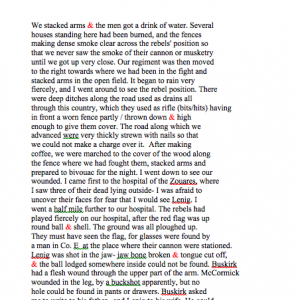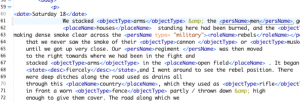As my final project for “Digging into the Digital”, I chose to look at the letters that James Merrill Linn wrote on April 18th, 20th and 21st. To get the most accurate answer to my research question, I chose to do a close reading. My research question is: “Was there any new information revealed from Linn’s diary entries on April 18th, 20th and 21st?” My answer is: Yes, a lot of new information was revealed to me. From reading these letters, I have discovered that he is writing all of this information to send to his brother, on April 18th they were preparing for battle, and that all the fighting occurs on April 19th. In addition, I have learned that that the Confederates won and that on the 21st, Linn is talking about the aftermath of what happened on April 20th.
Close reading helped to reveal that On April 18th Linn and his troops were traveling from Roanoke to Elizabeth City. Linn writes “Lt. Col. Bell called us all up- the officers & told us we should get our men ready to march in an hour back to Elizabeth City. That our safety depended on our doing it that night- that Gen.Reno had reliable information that large reinforcements had been sent for and would be there before morning.” They were all preparing for battle and following Lt. Col Bell’s and the officers’ instructions. On April 19th Reno marched to South Mills. Linn wrote “caps taken off. Then Beaver came in and told me the 21st
had formed & we were to form immediately,” and they were about to begin the fighting. During the battle of South Mills they were fighting the Confederate troops. After a long day of fighting, the war was over and the Confederates had defeated them. On April 21st ,Linn is in the cornfield near Elizabeth City. He writes “ we landed in a cornfield near Elizabeth City some one remarked that was always our luck, but it was not always our luck to have as bright and sunny day as we had now.” He talks about the aftermath of the South Mills battle. He says “One of our boats brought Stitzer, of Co. E. who had been wounded & left, who told us that about 30 their wounded & stragglers had left the battle field at 8 o’clock next morning and came through.” At the end is a note he wrote to his brother, where he says ““I send this act to you. You must keep it strictly confidential.” Linn didn’t want his brother to share all the information he had written about. At this point everything is revealed as to what he’s been doing by his writing; he’s been sending it all to his brother.
I approached my final project in five main steps. First, I copied and pasted the diary entries from the Google document into a word document.

I then decided to mark up the word types with different colors based on whether they were a place, people, object, event, dates, traits and states. People, organizations, things with proper names or titles were blue , places were gray, events were red, objects were green, dates and times were purple, traits were indigo and states were a brownish green. 
During the mark up process I had a little trouble. For example. I had no idea what cavalry was. I didn’t know whether it was an object, place, or person. So I looked it up on the Internet to find out that cavalry are soldiers who fought on horseback. So I then highlighted the word in blue.
The next step I did was adding tags. I tagged words with : “object type,” “persName,” “roleName,” “placeName,””time,” “role” and “date.”

After I was done with the tagging, I copied and pasted my work into oxygen.

The reason I worked in Microsoft word was because it was easier for me to tag and color code in there as opposed to oxygen. The last step I did was I added page breaks and made sure there was no red coloring and that it was completely green.
I then wrote down new information that was revealed to me on a document beside the one I had previously been working on.

I had to read the entries over a few times to make sure my information was correct. For example, at first I thought that April 21st revealed that the fighting was still going on but then when I went back and read it over again I realized that April 21st was just Linn talking about the aftermath of what occurred on April 19th. I learned other things while using close reading. I noticed that in the beginning he talked about objects a lot. I think he talked about objects because he was surrounded by so many at the time. For example: cannon, shell, ball, red flag and buckshot. Those are all objects that would be present in the preparation for war.
Overall close reading allowed me to understand what was happening in the diary entries and helped me to get the answer to my research question. I enjoyed working with Oxygen because it was very easy to maneuver. Throughout the semester I came to a realization that tagging and color coding were two beneficial techniques in helping to understand the context of Linn’s diary entries. I am glad I chose this as my final project because otherwise I would have never known the ending of Linn’s diary entries!
Bibliography:
Linn, James Merrill. Diary. 4/18, 4/20/ 4/21, 1862. MS. Bucknell University
Works Cited:
Battle of South Mills. (2014, November 29). Retrieved December 2, 2014, from http://en.wikipedia.org/wiki/Battle_of_South_Mills






